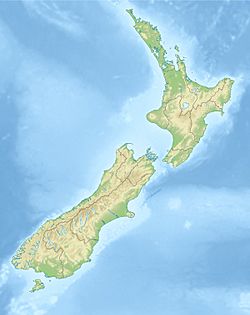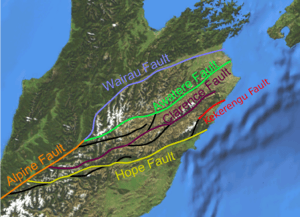1848 Marlborough earthquake facts for kids
| UTC time | 1848-10-16 |
|---|---|
| Local date | 16 October 1848 |
| Magnitude | Mw 7.5 |
| Depth | shallow |
| Epicenter | 41°48′S 173°42′E / 41.800°S 173.700°E |
| Areas affected | New Zealand, Marlborough, South Island |
| Casualties | 3 deaths |
The 1848 Marlborough earthquake was a very strong earthquake. It happened at 1:40 in the morning on October 16, 1848. The earthquake had a magnitude of about 7.5. Its center was in the Marlborough District of the South Island of New Zealand.
In Wellington, the shaking lasted for about two minutes. It caused a lot of damage, especially to buildings made of brick or stone. Most of the damaged buildings were later rebuilt using wood. This change helped reduce damage and save lives in the even stronger Wairarapa earthquake that hit Wellington seven years later.
How Earthquakes Happen in New Zealand
New Zealand sits on the edge of two huge tectonic plates. These are the Australian Plate and the Pacific Plate. These plates are always moving, but very slowly.
In the South Island, most of this movement happens along a big fault line called the Alpine Fault. A fault is like a crack in the Earth's crust. In the North Island, the movement mostly happens along the Kermadec subduction zone.
There's also a group of faults in the northern part of the South Island. This group is called the Marlborough Fault System. These faults help transfer the plate movement between the main plate boundaries.
What Happened During the Quake?
This earthquake was caused by a break in the Awatere Fault. This fault is part of the Marlborough Fault System. The break was at least 105 kilometers (about 65 miles) long.
The ground moved sideways by about 6 meters (nearly 20 feet). There were also smaller up-and-down movements. Scientists believe the earthquake started close to the surface. This is because there were many aftershocks felt after the main quake.
Scientists have estimated the earthquake's strength, or moment magnitude, to be about 7.5. They figured this out by looking at how long the fault broke and how much the ground moved.
How Did the Earthquake Affect People?
In Wellington, almost all buildings made of brick or stone were damaged. This included homes, churches, the jail, and the hospital. Most wooden buildings were okay, but many lost their brick chimneys.
Sadly, three people died in Wellington. Barrack Sergeant James Harris Lovel and two of his young children, Amelia (4) and William (6), were killed. They were crushed by falling bricks from a wall on Farish Street. They are buried in Bolton Street Cemetery.
In the Marlborough region, several homes were badly damaged. Some buildings that were hurt by the main earthquake were completely destroyed by strong aftershocks in the following days. The only other deaths from the earthquake happened when a damaged building fell apart during one of these aftershocks the next day.



